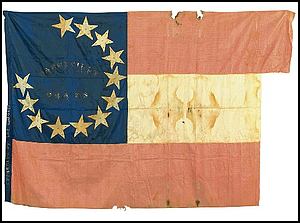 This flag was sold at auction by Sotheby's of
New York City, January 16, 2004, for $48,000. It was originally presented by The Ladies of
Dancyville to the Dancyville Grays, Company A, 9th Tennessee Infantry Regiment, General
Cheatham's Division.
This flag was sold at auction by Sotheby's of
New York City, January 16, 2004, for $48,000. It was originally presented by The Ladies of
Dancyville to the Dancyville Grays, Company A, 9th Tennessee Infantry Regiment, General
Cheatham's Division.DANCYVILLE GRAYS
FIRST NATIONAL FLAG
CIVIL WAR
 This flag was sold at auction by Sotheby's of
New York City, January 16, 2004, for $48,000. It was originally presented by The Ladies of
Dancyville to the Dancyville Grays, Company A, 9th Tennessee Infantry Regiment, General
Cheatham's Division.
This flag was sold at auction by Sotheby's of
New York City, January 16, 2004, for $48,000. It was originally presented by The Ladies of
Dancyville to the Dancyville Grays, Company A, 9th Tennessee Infantry Regiment, General
Cheatham's Division.
Dancyville, named after Isaac Dancy *¹, an early settler, is an old post village thirteen miles south of Brownsville, not far from the Fayette County line. It was established in 1837 by Fennel T. Carpenter and John Southerland, who were its first merchants. Company A, known as the Dancyville Grays, was recruited there, and inducted at Jackson, Tennessee in May of 1861. Most of the company members, the majority of whom were farmers, resided in Haywood and Fayette Counties. The Grays saw action at the battles of Shiloh, Perrysville, Murfreesboro, Chickamauga, Atlanta, Franklin and Nashville.
The flag has been in the possession of an extended local family since its fabrication 142 years ago, and was recently found in a trunk on a family farm. Accompanying it is an old handwritten note from May Curtis found pinned to it noting, This flag was made in 1861 by Martha Douglass McFarland *² at her death it was left to her daughter Anna McFarland Neblett and she willed it to her cousin Mollie Shaw Curtis my...(mother). Also accompanied by photocopies of Douglass and McFarland family history, information on the Dancyville Grays from the 1886 Military Annals of Tennessee-Confederate, and excerpts from a McFarland journal relating to the Civil War. Regarding the unusual materials of which the flag is made, it may be surmised that, due to the scarcity of materials during wartime, it was pieced together from dress materials, perhaps given up by the same ladies who presented it, rather than from the usual wool bunting or cotton. The three stripes have been shortened, two considerably more than the third, and it is quite possible that the material was removed after the war by surviving soldiers as souvenirs of their time in the company. This was a common 19th century military tradition.
DETAILED DESCRIPTION
Size ~ 7 feet x 5.5 feet
The blue silk canton containing twelve finely hand-sewn double-appliqu ecru silk stars in
an open-ended circle pattern, each ornamented with eleven equally-spaced spangles.
Centrally embroidered and sewn into this circle of stars is the name DANCYVILLE GRAYS,
rendered in silver-gilt thread and the same spangles as those found on the stars. The body
of the flag, rather than the characteristic upper and lower red stripes with a white
stripe sandwiched in-between, is made of rose-colored Swiss-dotted peau de soie, centered
by a stripe of the same ecru silk as that used in the stars. Hand-sewn to the entire hoist
of the flag is a darker blue moir silk sleeve, onto which is sewn, in the same spangles,
the legend Presented By The Ladies. These would have been the wives, sisters, sweethearts
and mothers of the soldiers in the regiment.
ADDENDUM
*1 Isaac Dancy , for whom Dancyville is named, was the community's first merchant (blacksmith) and the first postmaster. Isaac's youngest son, Alexander 'Sandy' Dancy , a member of the Dancyville Grays, would have fought and died under the flag. Sandy was killed in October 1862 and is buried in an unmarked grave at the Perryville Battle Field. A memorial stone has been placed at the Dancyville United Methodist Cemetery in his honor and memory.
*2 Martha Douglas McFarland was the daughter of Burchette Douglas , Fayette County banker, Constitutional Convention delegate, Tennessee Legistrator and War of 1812 veteran. She was the wife of Dr. Felix McFarland , one of Dancyville's earliest physicians.
![]()